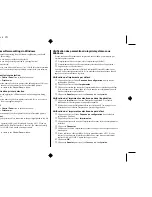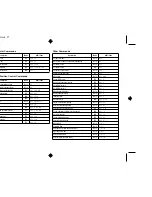
AppendixA.frame Black #23
103
Checking system software settings in MS-DOS
If you are using a parallel cable and cannot print a text file using the MS-DOS
command, you may have a problem with your AUTOEXEC.BAT file. Open
the file and look for the following line:
MODE LPT1:=COM1
or
MODE LPT1:=COM2
These lines indicate printing you are using a serial cable connection, and so you
should delete them, save the AUTOEXEC.BAT file, and try printing again.
Of course, if you are having problems printing with the optional Serial-To-Parallel
Interface Converter, you should conversely check to make sure that one of the above
lines is included in your AUTOEXEC.BAT file. The file must also contain
information on parameter settings. For details, see the user’s manual that comes with
the optional Serial-to-Parallel Interface Converter.
If the above is not the problem or if you make the above changes and still experience
problems printing using the MS-DOS
command, refer to your MS-DOS
Users’ Guide or consult with your software dealer.
If you are successful in printing using MS-DOS
command but cannot print
from an application, check to see what printer driver is select in the application. See
“Setting up for printing with MS-DOS” on page 75. If this does not help, consult
with your software dealer.
Checking the port settings in the User Setup Utility
❏
Start up the User Setup Utility (page 25).
❏
Select
Port
from the menu bar.
❏
Make sure that your printer cable is connected to the port selected in the list of
available ports.
If you are using a parallel cable, you will probably be using LPT1. If you are
using the optional Serial-To-Parallel Interface Converter, you should normally
be using COM1 or COM2.
❏
Exit the User Setup Utility and send the settings to the printer.
Vérification des paramètres du logiciel système sous MS-
DOS
Si vous utilisez un câble parallèle et que vous ne parvenez pas à imprimer un fichier
de texte au moyen de la commande
de MS-DOS, il peut y avoir un problème
au niveau du fichier AUTOEXEC.BAT. Ouvrez le fichier et vérifiez la ligne suivante:
MODE LPT1:=COM1
ou
MODE LPT1:=COM2
Ces lignes indiquent que vous utilisez une connexion série et vous devez les effacer,
sauvegarder le fichier AUTOEXEC.BAT et recommencez l’impression.
Bien entendu, si vous rencontrez des problèmes en imprimant avec le convertisseur
d’interface série/parallèle, vous devez vérifier qu’une de ces lignes figure dans le
fichier AUTOEXEC.BAT. Le fichier doit également contenir des informations sur
les valeurs de paramètres. Pour plus de détails, reportez-vous au Guide d’utilisateur
fourni avec le convertisseur d’interface série/parallèle optionnel.
Si le problème persiste, ou si vous continuez à rencontrer des problèmes
d’impression avec la commande PRINT de MS-DOS après avoir effectué ces
modifications, reportez-vous au Guide d’utilisation de MS-DOS ou prenez conseil
auprès de votre fournisseur de logiciel.
Si vous arrivez à imprimer avec la commande PRINT de MS-DOS, mais pas à partir
d’une application, vérifiez le gestionnaire d’imprimante sélectionné dans
l’application. Reportez-vous à la section «Configuration de l’impression sous MS-
DOS» à la page 75. Si vous n’arrivez pas à résoudre le problème, prenez conseil
auprès de votre fournisseur de logiciel.
Vérification des paramètres de port définis dans l’utilitaire
de configuration
❏
Lancez l’utilitaire de configuration (page 25).
❏
Sélectionnez
Port
dans la barre de menus.
❏
Vérifiez que le câble d’imprimante est connecté au port sélectionné dans la liste
des ports disponibles.
Si vous utilisez un câble parallèle, il s’agira probablement de LPT1. Si vous
utilisez le convertisseur d’interface parallèle/série, vous devez normalement
utiliser COM1 ou COM2.
❏
Quittez l’utilitaire de configuration en transmettant les valeurs de paramétrage à
l’imprimante.
















































